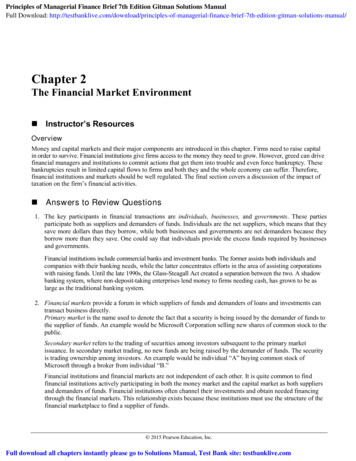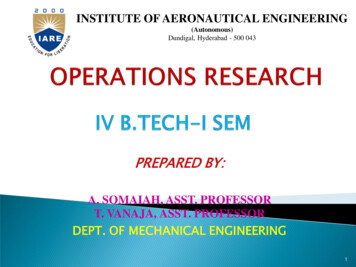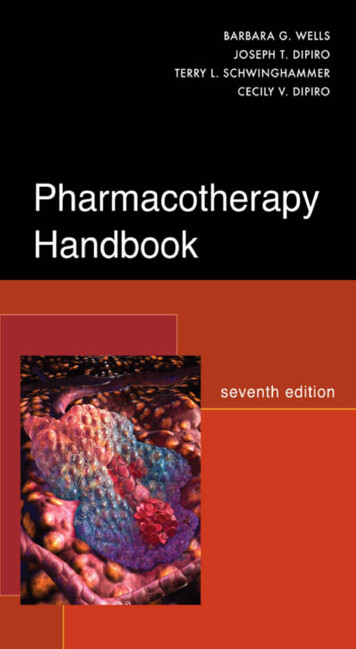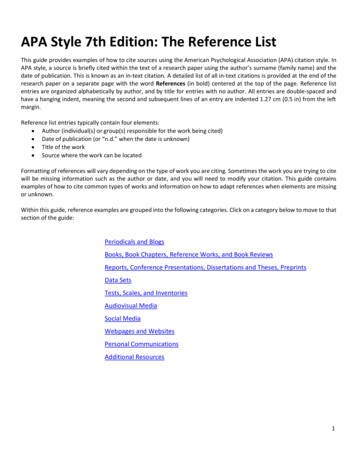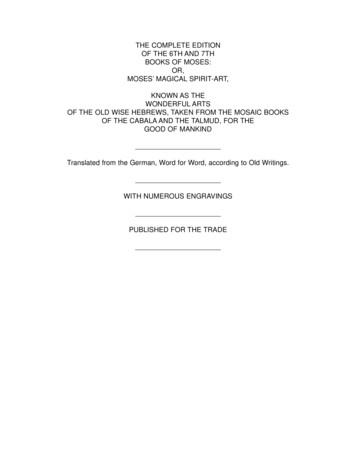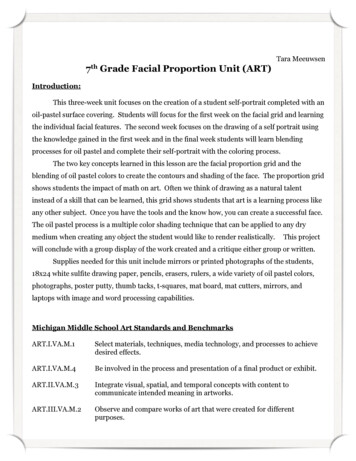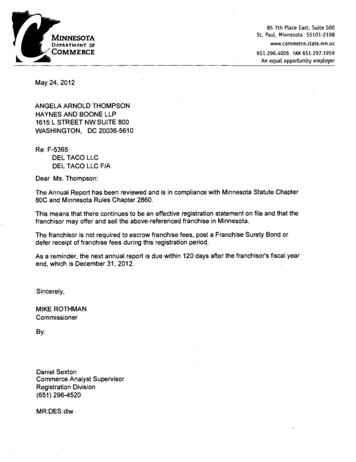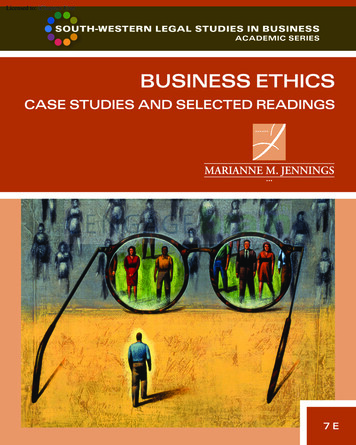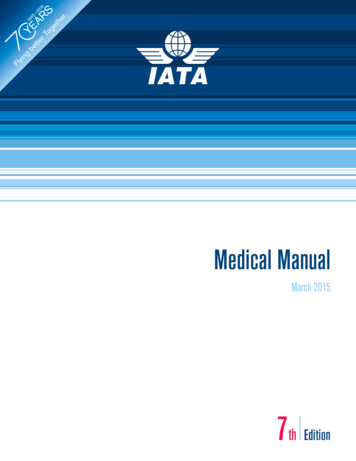
Transcription
Medical ManualMarch 20157th Edition
NOTICEDISCLAIMER. The information contained in thispublication is subject to constant review in the lightof changing government requirements and regulations. No subscriber or other reader should act onthe basis of any such information without referringto applicable laws and regulations and/or withouttaking appropriate professional advice. Although every effort has been made to ensure accuracy, theInternational Air Transport Association shall not beheld responsible for any loss or damage causedby errors, omissions, misprints or misinterpretationof the contents hereof. Furthermore, the International Air Transport Association expressly disclaimsany and all liability to any person or entity, whethera purchaser of this publication or not, in respect ofanything done or omitted, and the consequences ofanything done or omitted, by any such person or entity in reliance on the contents of this publication. International Air Transport Association.All Rights Reserved. No part of this publication may be reproduced, recast, reformattedor transmitted in any form by any means,electronic or mechanical, including photocopying,recording or any information storage and retrievalsystem, without the prior written permission from:Senior Vice PresidentSafety and Flight OperationsInternational Air Transport Association800 Place VictoriaP.O. Box 113Montreal, QuebecCANADA H4Z 1M1Medical ManualISBN 978-92-9252-576-7 2015 International Air Transport Association. All rights reserved.Montreal—Geneva
TABLE OF CONTENTSSECTION 1 – ROLE AND RESPONSIBILITIES OF AN AIRLINE MEDICAL DEPARTMENT . 11.1Introduction . 11.2Passenger Health . 11.2.1Medical Advice to Airline Passengers . 11.2.2MEDIF and FREMEC Cards (see also Section 6.3) . 11.2.3Passenger Awareness and the Media . 11.2.4Care of the Incapacitated Passenger . 21.2.5Global Communication . 21.3Employee Health . 21.4Position in the Corporate Organisation . 21.5Structure within the Medical Department . 31.6The Role of the Medical Department . 31.6.1Pre-Employment Assessment . 31.6.2Periodic Health Assessment . 41.6.3Care of Air Crew . 41.6.4Health Supervision of the Work Environment . 51.6.5Health and Safety Education. 51.6.6Accident and Emergency Services . 61.6.7Aircraft Accidents . 61.6.8Immunisation . 61.6.9Advice to Management . 7SECTION 2 – THE CABIN ENVIRONMENT . 92.1Introduction . 92.2Pressurisation . 92.3Ventilation . 102.4Contaminants . 102.5Temperature . 112.6Relative Humidity . 112.7Passenger Space Available . 122.8Noise and Vibration . 122.9Turbulence . 122.10Conclusion . 13SECTION 3 – CREW MEDICAL STANDARDS . 193.1Flight Crew Medical Standards . 193.1.1Rationale for Medical Standards . 193.1.2Environmental and Occupational Considerations . 19
Medical Manual3.23.1.3General and Specific Medical Considerations . 193.1.4Medical Standards. 203.1.5Selection and Initial Medical Examination . 203.1.6Responsibilities of Flight Crew . 203.1.7Responsibilities of the Airline Companies . 213.1.8Responsibilities of Authorised Medical Examiners . 21Cabin Crew Medical Standards . 213.2.1Cabin Crew Working Conditions . 213.2.2Aeromedical Assessment . 22SECTION 4 – OCCUPATIONAL HEALTH FOR AIR CREW . 234.14.24.34.4Sleep and Circadian Rhythms . 234.1.1Sleep Physiology . 234.1.2Alcohol . 244.1.3Sleepiness . 244.1.4Circadian Rhythms . 244.1.5Effect of Flight Operations . 254.1.6Strategies . 26Medication . 284.2.1Testing of Medication . 284.2.2Assessing Treatment Needs . 284.2.3Principles of Prescribing . 294.2.4Over-the-Counter Medications . 294.2.5Alternative Medicines . 29Travel Medicine . 304.3.1Principles of Risk Minimisation – Identification of Risk . 304.3.2Vaccinations and Travel . 304.3.3Important Diseases Associated with Travel . 314.3.4Environmental Issues . 324.3.5Jet Lag . 324.3.6Obligations of Airlines to Staff . 33Cosmic Radiation . 334.4.1Types of Radiation . 344.4.2Benefits and Risks of Radiation . 344.4.3Ionising Radiation on Earth . 344.4.4Cosmic Ionising Radiation . 354.4.5Measurement of Ionising Radiation. 364.4.6Exposure to Ionising Radiation . 364.4.7Radioactive Cargo . 37
4.4.8Occupational Exposure to Cosmic Radiation . 374.4.9Risks to Health . 384.4.10 Definitions . 39SECTION 5 – AIRCRAFT OPERATIONS . 415.1Food and Hygiene . 415.2Disinsection . 415.35.2.1Importance of Aircraft Disinsection . 415.2.2Legal Situation. 425.2.3General Principles of Aircraft Disinsection . 425.2.4WHO Recommended Disinsection Procedures (update 1998) . 435.2.5Considerations . 465.2.6Communication to Passengers and Crew . 47Cargo . 475.3.1Dangerous Goods . 475.3.2Emergency Treatment Following Exposure to Dangerous Goods Item . 485.3.3Storage and Handling of Toxic and Corrosive Materials. 485.3.4Transport of Dangerous Goods by Air . 49SECTION 6 – PASSENGER CARE . 506.16.26.3Fitness to Fly . 506.1.1Responsibility for Medical Clearance . 506.1.2General Guidelines for Medical Clearance . 506.1.3Passenger Categories . 506.1.4Logistics of Medical Clearance . 516.1.5Special Services . 516.1.6Specific Medical Guidelines . 51Airline Initial Emergency Medical Response Programmes . 576.2.1First Aid and Medical Response Kits . 576.2.2Cabin Crew Training . 576.2.3Air to Ground Communication . 586.2.4Automatic External Defibrillation . 586.2.5Telemedicine . 586.2.6Reporting of Medical Incidents . 596.2.7Handling of Deaths on Board . 59Medif Forms and Fremec Cards . 596.3.1IDENTIFYING PASSENGERS WITH REDUCED MOBILITY? . 596.3.2MEDIF . 606.3.3FREMEC . 60
Medical ManualSECTION 7 – MEDICAL INVOLVEMENT FOLLOWING AIRCRAFT INCIDENTS . 757.1Crisis Response . 75
INTRODUCTIONIATA commissioned this Medical Manual to provide up to date information on airline medical issues to itsmembers, especially those which may not have the benefit of an in-house medical advisor. The practice ofairline medicine has changed substantially since the last edition of the Medical Manual was written and this isreflected in the fully revised document. The Manual will be reviewed regularly to ensure it remains relevant tothe needs of IATA’s members.The Medical Manual has been compiled with the expert advice of the IATA Medical Advisory Group. Thiscomprises the medical directors of 12 airlines from all regions of the world. The knowledge and experience ofthe members of the Medical Advisory Group has been utilised to create a document that IATA is confident willmeet the needs of airlines throughout the world.The Medical Manual covers many of the facets of airline administration and operations from the medicalperspective. It draws on the various medical specialties that are essential to the safe and smooth operations ofan airline and includes public health, aviation medicine, occupational health and travel medicine.The content has been changed to reflect current issues of interest within the airline industry. Additionally, linksare provided to carefully researched websites which may be used for further information.
SECTION 1 – ROLE AND RESPONSIBILITIES OF AN AIRLINEMEDICAL DEPARTMENT1.1INTRODUCTIONThe airline medical department has wide ranging responsibilities that affect virtually every aspect ofthe airline operation and those using it. The areas of responsibility fall into two main categories: 1.2the health of the passenger;the health of the employee.PASSENGER HEALTHThe airline is responsible for carrying its passengers safely and efficiently to the destination. Theairline has no real means of ensuring that all passengers are fit to begin their journey. The medicaldepartment is responsible for ensuring, as far as possible, that passenger health does notdeteriorate during the journey, and that there are adequate measures in place to deal with anyunforeseen in-flight medical emergency.1.2.1Medical Advice to Airline PassengersDue to the marked increase of the number of airline passengers travelling abroad, the practice ofTravel Medicine and proper medical advice to the passenger by the airline medical department hasassumed great importance and is a major factor in successful airline operations.1.2.2MEDIF and FREMEC Cards (see also Section 6.3)Passenger health and medical fitness, along with advice to passengers who need medical clearanceor who have special needs is discussed in detail elsewhere in the manual. A summary is added herefor completeness: (Link: www.asma.org/publications)Many airlines provide medical clearance for passengers with recent or unstable medical conditions.Many use a special medical form based on the IATA Medical Information Form (MEDIF).Those passengers with chron
airline medicine has changed substantially since the last edition of the Medical Manual was written and this is reflected in the fully revised document. The Manual will be reviewed regularly to ensure it remains relevant to the needs of IATA’s members. The Medical Manual has been compiled w

